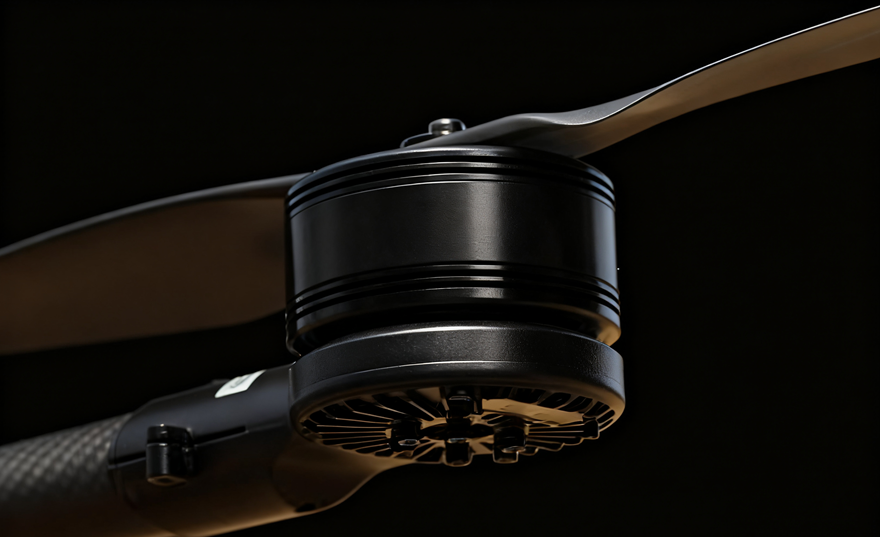在无人机系统中,电机扮演着决定飞行性能的“心脏”角色,它不仅直接决定推力输出,还影响响应速度、飞行稳定性、续航时间和载荷能力等一系列核心指标。
不同飞行场景下,飞行器重量、任务目标、操作环境差异巨大。比如Tiny Whoop室内穿越机强调灵敏轻盈,而Cinewhoop则更注重稳定与低噪音;竞速穿越追求爆发力,工业无人机则强调可靠性与长航时。
这些差异最终都会体现在电机的KV值、电机尺寸、推力余量与桨电匹配上,因此,电机选型不能“通用”,而必须根据实际场景匹配参数。如果你还不熟悉无人机电机的基础知识,可以先查看无人机电机指南,掌握选型与搭配的全局思路,再根据本文的场景分类做精确配置。
本文将围绕主流的六大应用场景,详细分析电机特性与搭配逻辑,帮助你在设计、DIY或选购无人机时更精准地配置动力系统。

一、Tiny Whoop/Toothpick超轻型无人机场景
1. Tiny Whoop/Toothpick场景特征
Tiny Whoop和Toothpick属于典型的微型无人机场景,广泛用于室内穿越、低速灵活飞行以及短时娱乐飞行。
这类无人机整机重量通常在20g~70g(不含电池)之间,飞行环境空间受限,对操控灵敏度要求很高,尤其注重电机的响应速度与轻量化设计。
飞手在狭小空间中频繁做小角度转弯、穿越门或障碍,因此动力系统要能够即时响应油门变化,同时尽可能降低惯性。
2. Tiny Whoop/Toothpick电机特征
Tiny/Toothpick使用的电机尺寸较小,多为0802、0902、1002、1102、1103等规格,KV值非常高,以保证在低电压(多为1S或2S)下仍能提供足够的转速和控制力。
这类电机通常采用无刷外转子结构,重量轻(约1.8g~4.5g),惯量低,能够实现毫秒级响应。
关键特性:
高KV值带来高转速,适合轻机身高灵敏度控制。
电机功率较小,但足以支撑30~70g级整机的飞行。
效率和重量的平衡至关重要,功耗越低,续航越长。
3. Tiny Whoop/Toothpick参数区间
项目 | 推荐区间 |
电机尺寸 | 0802 ~ 1103 |
KV 值 | 14,000 ~ 22,000 KV(1S~2S) |
推力(单电机) | 10 ~ 40 g |
推重比(整机) | ≥ 3:1 |
推荐电池 | 1S(主流)或 2S 锂电(高性能 Toothpick) |
例如:一台1S 0802 20000KV电机搭配31mm桨叶,单电机静态推力通常可达15~20g;而2S 1103 11000KV的组合则可以轻松实现35g以上的单电机推力,对应整机飞行重量约50g左右。
4. Tiny Whoop/Toothpick动力搭配建议
螺旋桨:使用直径31~65mm的轻量塑料桨,桨重越低越好,有助于提高响应速度。
ESC&FC:多为一体化AIO飞控(含ESC),ESC电流一般在5A~12A范围即可满足需求。
电池:1S是Tiny主流配置;2S可用于高性能Toothpick提升加速力。
飞控调校:适当增大油门响应曲线,提升操控精度。
结构设计:机架需轻量化(碳纤维或注塑框架),避免增加惯性。
二、Cinewhoop场景(穿越航拍)
1. Cinewhoop场景特征
Cinewhoop是近年来非常流行的一类无人机类型,其特点是在紧凑机身上搭载护桨结构,并配合高清或运动相机进行近景、低速、平稳的拍摄飞行。
这种场景强调的是飞行稳定性、震动控制和噪音抑制,而不是极限推力。
典型的Cinewhoop机体重量在250g~500g(含电池)左右,多在室内、城市、工厂、演出等相对受控环境中飞行。
2. Cinewhoop电机特征
Cinewhoop使用的电机普遍尺寸较小但扭矩比Tiny更强,如1404、1505、1804、2204等,KV值适中。
相较竞速电机,它们更强调输出的平滑与稳定,以及在护桨风道内维持效率的能力。
关键特性:
KV值适中(3000~4000KV),控制输出更线性。
在中低油门区域也能提供稳定推力,便于拍摄平稳画面。
电机效率优先于极限推力,发热量也相对可控。
需与护桨桨叶匹配,避免风道干扰造成效率下降。
3. Cinewhoop参数区间
项目 | 推荐区间 |
电机尺寸 | 1404 ~ 2204 |
KV 值 | 3000 ~ 4000 KV(3S~6S) |
推力(单电机) | 200 ~ 500 g |
推重比(整机) | 2.5:1 ~ 4:1 |
推荐电池 | 3S ~ 6S 锂电 |
例如:一颗1404 3600KV电机配3英寸桨,在4S电压下单电机可输出约300g推力;而2204 3700KV配4英寸桨可达到400~500g推力,适合承载运动相机或更大电池。
4. Cinewhoop动力搭配建议
螺旋桨:使用3~4英寸高效桨,桨形要与护桨结构配合良好,避免桨端过度干扰气流。
ESC&FC:建议使用20A~30A ESC(BLHeli_S/32),具备足够的电流冗余。
电池:3S是轻载航拍常见配置,4S~6S则用于中高推力Cinewhoop。
震动控制:电机输出平滑是保证画面稳定的关键,可搭配减震云台或软安装飞控。
飞控调校:注重低油门区域PID调校,避免抖动。
三、花式飞行场景
1. 花式飞行场景特征
Freestyle是FPV飞行中最具观赏性、也是最考验电机操控特性的飞行场景之一。
与Tiny或Cinewhoop不同,Freestyle强调的是“手感”——飞手在中高速飞行中完成翻滚、倒飞、停顿、悬停、漂移等动作,需要电机具备良好的线性响应、适中的爆发力以及精准的推力控制。
这类无人机整机重量通常在350g~650g之间(含电池),多使用5英寸桨叶,飞行环境通常为室外开阔区域。与竞速飞行不同,Freestyle不是极限加速,而是动作流畅和操控稳定优先。
2. 花式飞行电机特征
Freestyle使用的电机通常为2306、2207、2307、2408等规格。
这些电机拥有较大的定子体积,能在不牺牲重量的前提下提供足够的扭矩,确保电机在中低转速下也能精准控制机体姿态。
关键特性:
中高扭矩适合频繁姿态切换与定点停悬。
KV值中等(1700~2200KV)提供线性油门响应。
电机功率充足保证大幅度动作时的推力储备。
发热可控,长时间飞行不易过热。
特别是KV值的选择非常讲究:
KV太高虽然爆发力强,但油门不线性、飞行“暴躁”;
KV太低则响应迟钝、加速不够。
因此,Freestyle多采用中间段KV(如1950KV~2150KV for 6S),兼顾控制与推力。
3. 花式飞行参数区间
项目 | 推荐区间 |
电机尺寸 | 2306 ~ 2408 |
KV 值 | 1700 ~ 2200 KV(6S 主流) |
推力(单电机) | 1.2 ~ 2.0 kg |
推重比(整机) | 5:1 ~ 8:1 |
推荐电池 | 6S 锂电(常见 1050~1500mAh) |
例如:一颗2306 1950KV电机在6S配5×3.8英寸桨时,单电机静态推力约1.6kg左右,整机可达到6:1以上的推重比。
这种推力余量足以在中油门下完成大多数花式动作,同时保持飞行的可控性与平顺感。
4. 花式飞行动力搭配建议
螺旋桨:建议使用5英寸桨叶(如5×3.6、5×4.3),桨形对响应和油门曲线影响极大。
桨螺距大意味着爆发力更强,响应更“冲”
桨螺距小意味着更平顺,飞行更“稳”
ESC&FC:建议45A~55A ESC,支持BLHeli_32,留有电流冗余,保证油门响应无延迟。
电池:6S配合中KV是主流配置(1050~1500mAh),可平衡爆发力与续航。
整机重量控制:总重越轻,所需推力越低,飞行越灵活;但电机推力要有足够余量避免“虚油门”。
四、FPV竞速场景(Racing FPV)
1. FPV竞速场景特征
FPV竞速(Racing)是最能体现无人机电机极限性能的飞行场景。
这类无人机专门用于比赛和高速穿越,要求在极短时间内完成连续弯道、高速冲刺和急停急起等动作。
与Freestyle相比,竞速机的飞行风格更“爆”,动作更极端。
电机必须能在极短响应时间内输出最大推力,并在长时间高负载下保持稳定运行。
整机重量一般在350g~600g(含电池)之间,但电机推力却普遍能达到单电机2kg左右,推重比高达8:1甚至10:1,远超其他类型无人机。
2. FPV竞速电机特征
竞速机普遍采用2205、2207、2306、2307这类中等尺寸但高KV的电机。
其核心特点是:
KV值高(1800KV~2800KV),最大转速高;
输出爆发力强,响应极快;
电机线圈与磁体设计注重功率密度与耐温;
在高电流、高温环境下依然保持稳定工作。
KV值选择与电池电压高度相关:
4S机型常用KV值在2300~2800KV区间;
6S机型则多在1800~2100KV区间。
这能在不同供电电压下实现近似的螺旋桨转速和飞行手感。
KV太高虽然能提供爆发力,但也带来更高的电流与发热;KV太低则推力不足,难以维持竞速节奏。竞速电机的关键在于:最大爆发+最短响应时间+高温高载稳定性。
3. FPV竞速参数区间
项目 | 推荐区间 |
电机尺寸 | 2205 ~ 2307 |
KV 值 | 1800 ~ 2800 KV(4S/6S) |
推力(单电机) | 1.5 ~ 2.5 kg |
推重比(整机) | 6:1 ~ 10:1 |
推荐电池 | 4S 或 6S(850~1300mAh,C 值≥ 75C) |
例如:一颗2306 2400KV电机在4S电压下搭配5×4.3英寸桨叶,单电机静态推力可达约2.2kg,整机推重比约9:1,适合高强度竞速冲刺。
相同场景下,若换成6S+1950KV电机,则可获得类似转速,但电流更低、效率略高,发热也更可控,因此6S逐渐成为主流竞速配置。
4. FPV竞速动力搭配建议
螺旋桨:
5英寸竞速桨(常见桨距4.3~5.1),采用轻量高强度材料;
桨越“硬”、螺距越大意味着推力越猛,响应越快,但功耗也更高;
建议根据比赛节奏选择螺距,避免高KV+高螺距导致电机过载。
ESC&FC:
建议使用45A~60A ESC(BLHeli_32),保证高电流稳定性;
建议开启电流保护功能,避免因拉爆油门烧ESC。
电池:
4S机型:KV高、瞬时电流更大,适合短赛道快速穿越;
6S机型:KV较低,电流相对温和,爆发力强、效率更佳;
电池放电倍率建议≥75C,容量850~1300mAh为主流。
整机结构:
竞速机对重量非常敏感,尽量减轻电机、桨叶和机架重量;
飞控调校需响应迅速,滤波与PID设置需紧凑无拖滞。
五、工业与载荷运输场景
1. 工业无人机场景特征
工业级无人机与FPV竞速、Freestyle的飞行需求完全不同。
这类无人机多用于农用喷洒、物资运输、线路巡检、测绘等任务,具有以下几个显著特点:
负载重量大,单机起飞重量往往在5kg~100kg甚至更高;
飞行时间长,通常要求30分钟甚至1小时以上;
任务稳定性优先,允许飞行速度不高;
安全冗余、系统可靠性是首要考量。
因此,工业无人机的电机系统强调的是:高效率、大扭矩、大推力、低转速、长寿命。
2. 工业无人机电机特征
工业无人机广泛使用大尺寸低KV值的无刷外转子电机,典型规格如4010、5010、6010、8010、8318等。
这类电机有更大的定子体积和磁通量,能在较低转速下产生巨大的扭矩和推力,特别适合搭配大桨,显著提升系统效率。
关键特性:
低KV(100~400KV):降低转速,提升桨效,减小功耗;
高扭矩输出:驱动大直径螺旋桨,适应重载;
高效率、低热损:支持长时间连续作业;
寿命长:轴承、绕组、磁钢可靠性高,适合工业环境;
支持多电机协同工作(如六旋翼、八旋翼等),满足大载荷任务。
3. 工业无人机参数区间
项目 | 推荐区间 |
电机尺寸 | 4010 ~ 6010+(大型机型可用 8010/8318) |
KV 值 | 100 ~ 400 KV |
推力(单电机) | 2 kg ~ 20 kg+ |
推重比(整机) | ≥ 2.5:1(工业任务推荐 3:1 以上) |
推荐电池 | 6S ~ 12S(大容量高倍率电池) |
举例说明:
一颗5010 320KV电机配17英寸碳桨,单电机静态推力可达4kg左右,适合中载荷巡检无人机;
8318 100KV电机配30英寸桨叶,可实现单电机15kg以上推力,适用于物流运输或大型农用无人机。
低KV值的核心优势是高效率。
比如在同样推力下,100KV的大电机+30寸桨的功耗明显低于高KV小电机+10寸桨,从而显著提升航时。
4. 工业无人机动力搭配建议
螺旋桨:
建议使用13~30英寸碳纤维桨叶,桨形优化以提升桨效;
桨直径越大,电机转速越低,效率越高。
多旋翼设计(六轴/八轴)可降低单电机负载,提高系统冗余。
ESC&FC:
ESC电流需求高(60A~200A),但更注重工作稳定性与热管理;
需具备软启动与防堵转保护,避免重载起飞烧电机。
工业无人机多使用冗余飞控和电源管理模块。
电池:
6S~12S大容量高倍率电池,容量普遍10,000mAh以上;
高电压+低KV组合有助于提升系统整体效率。
结构与冷却:
电机通常外露以利于散热;
重载机型会加入强制风冷或液冷模块以应对长时间高功率飞行。
六、VTOL场景
1. VTOL场景特征
特种与科研类无人机涵盖了固定翼垂直起降(VTOL)、混合翼布局、长航时巡航机、科研实验平台等机型。
这类机型最大的特点是兼具垂直起降能力+高效巡航能力,因此飞行任务复杂,对电机系统的要求也更高。
常见应用场景包括:
电力/管线/森林等大范围巡检
科研测试平台(空气动力、导航实验)
长航时固定翼任务(1~5小时级别)
高原、海上或其他特殊飞行环境
与FPV或工业多旋翼不同,这类无人机需要同时满足两种动力学工况:
起飞/降落需要高推力,短时间爆发力强
巡航飞行需要高效率,功耗低,稳定性强
因此,它们往往采用“双动力系统”设计:
一组低KV、大桨电机负责垂直起降(VTOL);
另一组中KV、高效率电机负责巡航飞行。
2. VTOL电机特征
VTOL/混合翼机型通常采用以下两类电机:
(1)起飞电机
低KV值(100~400KV),大尺寸外转子;
提供高扭矩、高推力,支持短时间高功率爆发;
多为多旋翼布局(四轴、六轴、八轴)安装在机翼或机身两侧。
(2)巡航电机
中KV值(700~1200KV),配合定距或变距桨;
输出平稳、高效率,适合长航时飞行;
安装在机体尾部或机头位置(类似固定翼螺旋桨机)。
关键特性:
双电机系统分工明确,提高整体能效;
起飞电机占用时间短,但要求可靠;
巡航电机承担绝大多数能耗,对效率和稳定性要求极高;
系统设计需考虑动力协同与冗余。
3. VTOL参数区间
项目 | 起飞电机 | 巡航电机 |
电机尺寸 | 4010 ~ 8318+ | 2212 ~ 2814+ |
KV 值 | 100 ~ 400 KV | 700 ~ 1200 KV |
推力(单电机) | 2 kg ~ 20 kg+ | 0.5 kg ~ 5 kg |
推荐电池 | 6S ~ 12S | 4S ~ 6S |
设计目标 | 爆发力 / 垂直升力 | 高效率 / 巡航稳定性 |
举例说明:
一台20kg起飞重量的VTOL无人机可能搭载4颗8318 100KV电机配30寸桨叶完成垂直起降;
巡航阶段则使用一颗2814 900KV电机配12寸桨叶推进,功耗约400W,巡航时间可达2小时以上。
这种动力系统设计兼顾了大载荷起降能力与长航时高效巡航。
4. VTOL动力搭配建议
螺旋桨
起飞桨:大直径固定桨(如24~30寸碳桨),保证垂直推力;
巡航桨:中等直径(10~14寸),优先考虑效率;
变距桨可进一步优化巡航效率。
ESC&控制系统
起飞电机ESC要有高电流冗余(≥60A),支持高功率瞬时输出;
巡航ESC则强调低功耗运行稳定性。
飞控需支持多动力模式切换(VTOL→FIXED-WING)。
电池与供电
常用高电压系统(6S~12S)统一供电,降低电流损耗;
必要时使用双电池或混合动力系统(油电/电电分离)。
冗余与安全
起飞电机系统可冗余配置,确保即便一颗失效仍可安全降落;
巡航电机需要可靠的温控与功率管理,避免长时间飞行过热。
七、总结
无人机电机的选型本质上是一场在推力、效率、响应与重量之间的平衡博弈。
不同飞行场景只是放大了这种权衡的不同侧重点:有的优先灵敏控制,有的强调航时与稳定,有的则追求极限性能。
电机参数(如KV值、定子尺寸、扭矩)本身并不具备场景属性,真正起决定作用的,是它们与桨叶、供电、电控系统之间的匹配关系。
一颗电机是否适合某种任务,不取决于规格表上的数字,而取决于它在特定工况下的真实推力曲线与功耗表现。
遵循“场景→推力目标→电机参数→动力搭配”这种自上而下选型方式,远比“先买电机再凑配置”高效得多,一个恰当的电机选型,不仅意味着更好的飞行体验,也代表着更高的效率、更长的航时和更低的维护成本。
